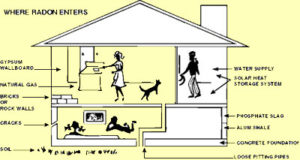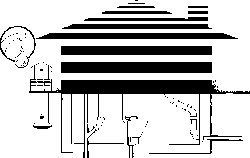Sources of Radon in the Home

Radon gas can enter a home from the soil under the house by process of diffusion through concrete floors and walls, and through cracks in the concrete slab, floors, or walls and through floor drains, sump pumps, construction joints and cracks or pores in hollow-block walls. Normal pressure differences between the house and the soil can create a slight vacuum in the basement, which can draw radon from the soil into the building. The design, construction and ventilation of the home can affect the radon levels of the home.

Well water can be another source of indoor radon. Radon released by well water during showering or other activities may release radon gas into the home.
Radon in water is a much smaller factor in radon exposure than radon in soil.Radon exposure outdoors is much less of a risk than indoors because the radon is diluted to low concentrations by the large volume.

